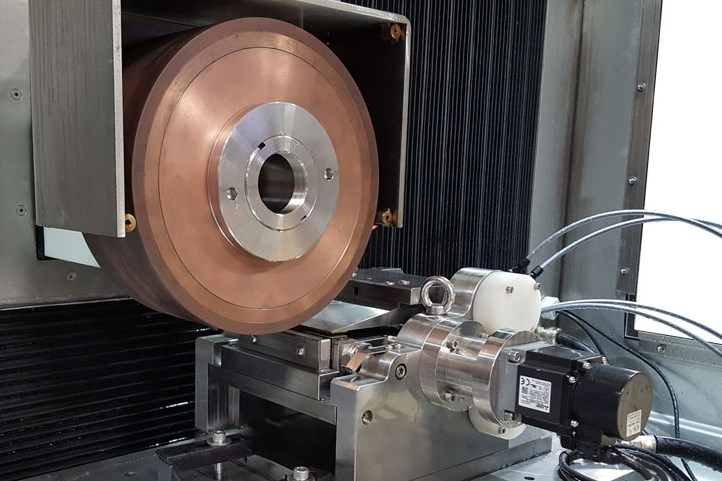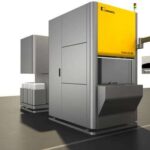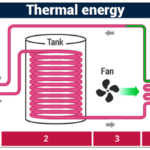Electrochemical Grinding, or ECG, is a variation of ECM (Electrochemical Machining) that combines electrolytic activity with the physical removal of material by means of charged grinding wheels. Electrochemical Grinding (ECG) can produce burr free and stress free p arts without heat or other metallurgical damage caused by mechanical grinding, eliminating the need for secondary machining operations. Like ECM, Electrochemical Grinding (ECG) generates little or no heat that can distort delicate components.
Electrochemical Grinding (ECG) can process any conductive material that is electrochemically reactive. The most common reason customers choose Electrochemical Grinding (ECG) is for the burr free quality of the cut. If a part is difficult or costly to deburr, then ElectrochemicalGRINDING (ECG) is the best option. Materials that are difficult to machine by conventional methods, that work harden easily or are subject to heat damage are also good candidates for the stress free and no heat characteristics of Electrochemical Grinding (ECG). The stress free cuttingcapability of the process also makes it ideal for thin wall and delicate parts.
The real value of Electrochemical Grinding (ECG) is in metalworking applications that are too difficult or time-consuming for traditional mechanical methods (milling, turning, grinding, deburring etc.). It is also effective when compared to non-traditional machining processes such as wireand sinker EDM. Electrochemical Grinding (ECG) is almost always more cost effective than EDM.
Electrochemical Grinding (ECG) differ from conventional grinding Conventional surface grinding typically uses shallow reciprocating cuts that sweep across the work surface to create a flat plane or groove. Another conventional surface grinding process, creep feed grinding, typicallyuses slower feeds than conventional surface grinding and removes material in deep cuts. Because of the abrasive nature of these processes, the equipment used must be rigid and this is especially true of creep feed grinding.

Quality Electrochemical Grinding (ECG) machines must also be rigid for close tolerance results but since very little of the material removed is done so abrasively the machines do not have to be as massive as their conventional counterparts. To a user familiar with creep feed grinding Electrochemical Grinding (ECG) will appear to be very similar, that is, relatively slow feeds (as compared to conventional surface grinding) and deep cuts as opposed to shallow reciprocating cuts. Electrochemical Grinding (ECG) is a combination of electrochemical (Anodic)dissolution of a material, according to Faraday’s Law, and light abrasive action. The metal is decomposed to some degree by the DC current flow between the conductive grinding wheel (Cathode) and the work piece (Anode) in the presence of an electrolyte solution.
Unlike conventional grinding techniques, Electrochemical Grinding (ECG) offers the ability to machine difficult materials independent of their hardness or strength. Electrochemical Grinding (ECG) does not rely solely on an abrasive process; the results are precise burr free and stress free cuts with no heat and mechanical distortions.

Electrochemical Grinding (ECG) compare to EDM, laser, water-jet and other non-traditional technologies EDM and laser both cut metal by vaporizing the material at very high temperatures.
This results in a re-cast layer and a heat affected zone on the material surface. Electrochemical Grinding (ECG) is a no heat process that never causes metallurgical damage. Electrochemical Grinding (ECG) is usually much faster than EDM but typically is less accurate. Laser cutting can be very fast and accurate but it is normally limited to thin materials. Water -jet cutting can be quite fast and usually leaves no metallurgical damage but the consumable costs can be very high and the cuts are limited to jigsaw type cuts much like Wire EDM. In most cases, ElectrochemicalGrinding (ECG) is a more accurate process than water-jet. Another difference between water jet and laser machining compared to electrochemical grinding (ecg) is laser and water jet can both process materials that are not conductive. edm and electrochemical grinding (ecg) processes canonly work on materials that are conductive.
Tolerances can be achieved with electrochemical grinding (ecg) the tolerances that can be achieved using electrochemical grinding (ecg) depend greatly on the material being cut, the size and depth of cut and ecg parameters being used. On small cuts, tolerances of .0002” (.005mm) can be achieved with careful control of the grinding parameters.
Surface Finishes Can Be Achieved With Electrochemical Grinding (Ecg)
The Electrochemical Grinding (ECG) process does not leave the typical shiny finish of abrasive grinding. This is because there is no smearing of the metal as in conventional grinding. A 16 micro inch finish or better can be achieved but it will have a matte (dull) rather than a polished look.
Materials Can Be Cut With Electrochemical Grinding (ECG)
Almost any conductive metal can cut with Electrochemical Grinding (ECG). Steel, Aluminum, Copper, Stainless Steels, Inconel and Hastelloy cut very freely with Electrochemical Grinding (ECG). Nickel/Titanium, Cobalt alloys, Amorphous metals, Berilium, Berilium Copper, IridiumNeodymium Iron Boron, Titanium, Nickel/Titanium, Nitinol, Powdered Metals, Rene 41, Rhenium, Rhodium, Stelllite, Vitalium, Zirconium and Tungsten can also be cut effectively.
Advantages of Electrochemical Grinding (ECG)
• Improved wheel life
• Burr free
• No work hardening
• Stress free
• Better finis
• No cracking
• Less frequent wheel dressing
• No metallurgical damage from heat
• Faster for tough materials
• No wheel loading or glazing
• More precise tolerances


